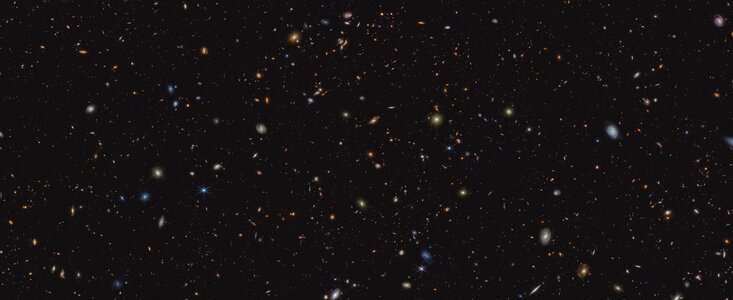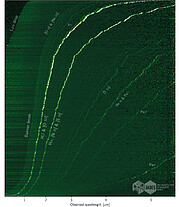sci25006 — Announcement
JADES Data Release 4
27 October 2025
-By Emma Curtis-Lake (Hertfordshire), on behalf of the JADES Consortium-
The JWST Advanced Deep Extragalactic Survey (JADES) is a collaboration between the Guaranteed Time Observation teams of the NIRCam and NIRSpec instruments. The goal of JADES is to reveal the physical properties of galaxies in the young Universe, from when it was less than two billion years old up to the formation of the first galaxies right after the Cosmic ‘Dark Ages’.
We are delighted to announce the fourth JADES data release (DR4), which presents the complete NIRSpec spectroscopic dataset. This release contains 5190 spectra across the GOODS-North and GOODS-South fields, including the iconic Hubble Ultra Deep Field. The sample spans the extended wavelength coverage of NIRSpec, from 0.8 to 5.5 microns, with both low-dispersion prism observations (R~30-300) and medium-resolution gratings (R~1000). Nearly 2700 galaxies were also observed with the high-resolution G395H grating (R~2700), enabling detailed studies of galaxy kinematics and faint emission features.
A key highlight of DR4 is the inclusion of the full-depth deep pointing in the JADES Origins Field, with more than 20 hours of integration per target. This dataset covers some of the most distant and intriguing galaxies yet identified, including JADES-GS-z14-0 and JADES-GS-z13-LA-1, which provide critical insights into galaxy formation only a few hundred million years after the Big Bang. Altogether, DR4 provides robust spectroscopic redshifts for 3297 galaxies, nearly 400 of them at z>5.7, opening a detailed window onto galaxies from cosmic dawn through to cosmic noon.
Importantly, DR4 supersedes earlier spectroscopic releases (DR1 and DR3). All previously released spectra have been re-processed with improved calibrations to provide science-ready products, while spectra compromised by detector shorts have been excluded. Newly observed pointings are also included, ensuring that DR4 represents the final, complete JADES spectroscopic sample.
We are also happy to announce that we have provided a searchable database which enables filtering the JADES spectroscopic catalogue by redshift, redshift quality flag, emission line fluxes or search by coordinates and search radius. The online database displays the NIRCam stamps, best fits to the R100 and R1000 data as well as the ability to download the full catalogue of measured emission-line fluxes based on the search and filters. The DR4 products will also be available here in due course as Higher-Level Science Products through the Mikulski Archive for Space Telescopes. The two papers describing the DR4 products are available here and here. Together, these data represent the most comprehensive spectroscopic view yet of galaxy formation and evolution in the early Universe.
The NIRSpec instrument was provided by ESA, and was built by a consortium of European companies led by Airbus Defense and Space, with NASA’s Goddard Space Flight Centre providing its detector and micro-shutter subsystems. NIRCam was provided by the University of Arizona.
Contacts
Chris Evans
ESA/HST & ESA/JWST Project Scientist
ESA Office, STScI Baltimore, USA
Email: [email protected]
About the Announcement
| Id: | sci25006 |
|---|


